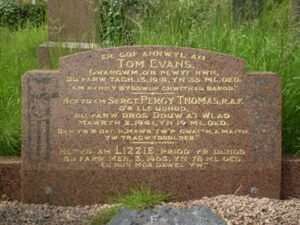Llanpumsaint is a small village which lies in the Gwili valley, near Bronwydd Arms. The Parish Church has ancient origins and dates from the 5th or 6th Century and to the south of the village lie the remains of a possible motte and bailey castle. Llanpumsaint was a stop on the Carmarthen to Aberystwyth railway, but closed in 1965. Llanpumsaint and Ffynnon Henry Memorial Hall was opened in 1928 and houses the local war memorials. These commemorate three men who died during World War One and another three who died during World War Two. Another memorial, with the names of three other men, was removed from Bethel Chapel when it closed and was brought to the memorial hall in 2014. This additional plaque has been affixed below the existing two and is not visible in the photograph below.
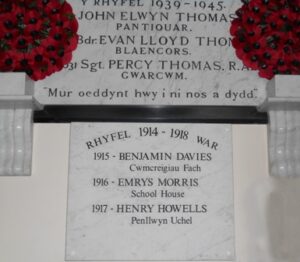
The Great War, 1914-1918
William John Bowen, Private, 73978, Notts & Derby (Sherwood Foresters). William was born in Llanpumsaint in 1885, the son of David and Margaret Bowen. He lived with his wife Elizabeth Bowen (nee Williams) and their four children at 13, Coychurch Road, Bridgend prior to the war. He enlisted at Cardiff on 26 July 1916 into the 7th Welsh, embarking for France in September 1917 and joined the 15th Welsh. He served with the Carmarthen battalion for a week, before being reposted to the 10th Welsh. On 27 February 1918 the 10th Welsh was dissolved, and William joined No. 1 Entrenching Battalion, before again moving to the 2nd Battalion, Sherwood Foresters, part of 18 Brigade, 6th Division. By then the Division was taking part in the great offensive, and it was on 19 September 1918, during the Battle of Épehy, that William was killed. He is buried at Trefcon British Cemetery, Caulaincourt, France.
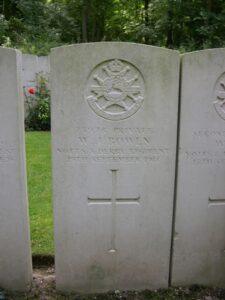
Benjamin Davies, Private, A/413, Kings Royal Rifle Corps. Benjamin was the son of Ben and Rachel Davies, of Neaudd Deg, Llanpumsaint. He had enlisted at London into the 7th Battalion, King’s Royal Rifle Corps, which was attached to 41 Brigade, 14th (Light) Division, and landed at Boulogne on 19 May 1915. The Division moved into positions east of Ypres, and became the first British unit to be attacked by German flamethrowers during the German assault at Hooge on 30 July, 1915. The 7th KRRC were positioned on the south side of the newly blown Hooge Crater, when at 3.15 p.m. jets of fire shot across from the German trenches towards their positions, and then a German Artillery Barrage saturated the ground. Vicious hand to hand fighting ensued, but the Germans didn’t follow up their attack, and the line stabilised again. Benjamin must have been wounded here, and evacuated home for treatment, as he is recorded as having died of wounds at Shorncliffe Hospital on 15 October 1915. He was 23 years old, and is buried in Llanpumsaint (Saer Calem) Baptist Chapelyard.
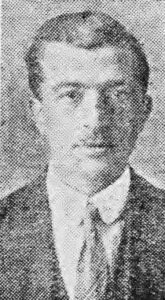
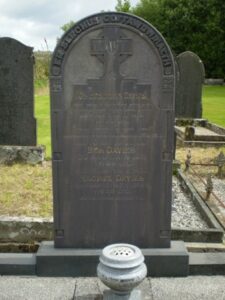
John Griffiths, Sergeant, 13126, Welsh Regiment. John was born at Waenfawr, Llanpumsaint in 1895, the son of Sarah Griffiths. He enlisted at Tumble into the 9th Battalion, Welsh Regiment, which was attached to 58 Brigade, 19th (Western) Division. The battalion crossed to France on 18 July 1915, and moved with the division to positions near Loos. The Division fought during the opening attack of the Battle of Loos, and then moved to the Somme, where they took part in the second wave of the attack on Ovillers-La Boisselle on 1 July, capturing the village at heavy cost, and fought through the Somme Battles of Pozières and the Ancre in 1916. They then moved North to Ypres, taking part in the Battle of Messines, and fought on the Menin Road and at Polygon Wood, before moving up to Broodseinde, Poelcapelle and Passchendaele Village itself. In 1918 they were caught up in the German Spring Offensive near St. Quentin, where they suffered terrible casualties, and fought at the Battle of Bapaume. They moved to Ypres, but were caught up in the German attack at Messines, and at Bailleul, and Kemmel. After suffering terribly again, they moved south to the quieter French sector to rebuild, but were caught up in the German offensive on the Aisne, and fought during the Battle of the Selle, Valenciennes, the Sambre and the Passage of the Grand Honelle. John was killed during the Battle of the Sambre, on 4 November 1918, aged 23. He is buried at Cross Roads Cemetery, Fontaine-Au-Bois.
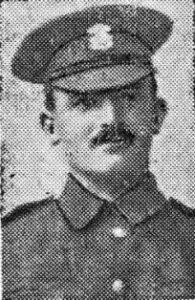
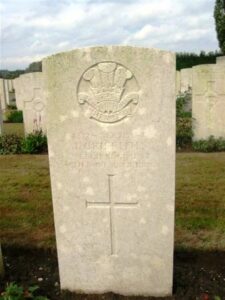
Harry Howells, Company Sergeant Major, 54246, Welsh Regiment. Harry was born in Penllwynuchel, Llanpumsaint, the son of William and Susannah Howells. The family later resided at 7, John Street, Carmarthen. He was one of the early volunteers who joined the Carmarthen Pals, the 15th Battalion, Welsh Regiment, which trained at Rhyl before moving to Winchester as part of 114 Brigade, 38th (Welsh) Division. The Division landed in France in December 1915, and were sent to positions around Fleurbaix for familiarisation. In June 1916 the Division marched to the Somme, where it took part in the capture of Mametz Wood. Harry was wounded at Mametz, and sent home to recuperate. He rejoined the battalion at Boesinghe, and soon became promoted CSM. On 26 May 1917, the battalion was in support at the Canal Bank, and Harry was supervising a wiring party, when he was shot in the leg. He was brought to the Canadian Casualty Clearing Station at Mendinghem for treatment, but had to have his leg amputated, and died there on 5 June 1917. He was 23 years old, and is buried at Mendinghem Military Cemetery, Belgium.
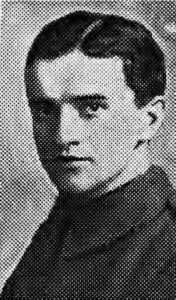
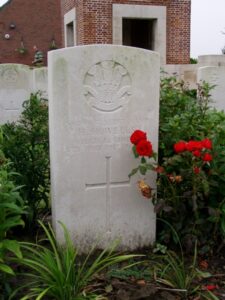
Daniel Lewis, Sapper, 145726, Royal Engineers. Daniel was the son of John and Mary Lewis, of Bwlchyrhyd, Llanpumsaint. He worked for Mr John Daniel, Builder, of Gwyn Villa, Bronwydd Arms prior to the war, and resided there with the family. Daniel enlisted into the Royal Engineers in February 1916, and was posted to No. 8 Depot Company in Llandudno. Daniel became ill with meningitis, and died at Bangor Hospital on 8 April 1916. He was 25 years old, and was brought home to be buried at Llanpumsaint (Saer Calem) Baptist Chapelyard. Many thanks to Bev Lewis, of Swansea for the photograph of Daniel’s grave.
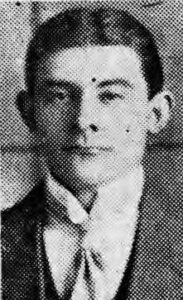
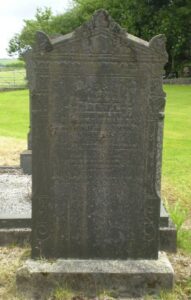
Emrys Morris, Private, 19865, Royal Fusiliers. Emrys was born at Llanpumsaint, the son of Griffith and Margaret Morris. His father was the headmaster of the local school. The family later lived at Ardrum, Palace Avenue, Llanelli, following Griffith being offered the headship of Y Bryn School. Emrys enlisted at Swansea into the 26th Battalion, Royal Fusiliers, which was known as the Bankers Battalion, attached to 124 Brigade, 41st Division. This Division was formed in September 1915, and moved to France by 6 May 1916, concentrating near Steenwerck, where they began familiarisation with trench warfare in the areas of Ploegsteert and the Douve valley, south of Ypres. Emrys was killed at Ploegsteert when he was shot whilst on sentry duty on 20 July 1916. He was 18 years old, and is buried at Berks Cemetery Extension, Belgium.
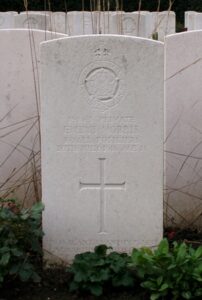
World War Two, 1939-1945
David Elwyn Griffiths, Signalman, 2353492, Royal Corps of Signals. David was the son of David and Naomi Griffiths, of 7 Frederick Street, Ferndale. His father was from Llanpumsaint, and David and his brothers and sisters were regular visitors to family back in the village. David enlisted into the Royal Corps of Signals, and was posted to North Africa with the Mobile Corps Signals. He was killed in action during the 8th Army’s assault on the Gazala Line on 14 December 1941. David was 30 years old, and is commemorated on the Alamein Memorial, Egypt. His brother John also fell. David is not commemorated locally.
John Howard Griffiths, Sergeant, 1337841, Royal Air Force Volunteer Reserve. John was the son of David and Naomi Griffiths, of 7 Frederick Street, Ferndale. His father was from Llanpumsaint, and John and his brothers and sisters were regular visitors to family back in the village. He served as a Navigator with 166 Squadron, Royal Air Force, which was a bomber squadron, equipped with the Vickers Wellington, based at RAF Kirmington. John was killed on the morning of 24 May 1943, when his Wellington was shot down over Holland. He was 21 years old, and is buried at Amsterdam New Eastern Cemetery, Netherlands. His brother David also fell. John is not commemorated locally.
James Elwyn Thomas, Driver, T/177397, Royal Army Service Corps. James was the son of John and Edith Thomas, of Bronwydd Arms. He served with the 15th Division Composite Company, Royal Army Service Corps. James died on active service in Northumberland on 7 June 1942, aged 26, and was brought home for burial in Llanpumsaint Churchyard.
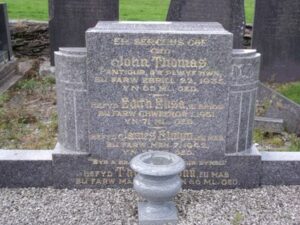
Percy Thomas, Sergeant, 967631, Royal Air Force Volunteer Reserve. Percy was born in 1921, the son of Rees Thomas and Lizzie Thomas (formerly Evans), of Gwarcwm, Llanpumsaint. He enlisted into the Royal Air Force Volunteer Reserve and after completing his training as a Wireless Operator/ Air Gunner was posted to 61 Squadron, Royal Air Force, which was based at Wick, and equipped with the Handley Page Hampden. On the night of 1 March 1941, Percy was one of the crew members aboard a Handley Page Hampden, Serial X3147, which took off from RAF Hemswell, Lincolnshire as part of a force of over 130 aircraft bound for Cologne. The raid was a success, but when the aircraft returned to England, the ground was found to be covered in a thick fog. Percy’s Hampden ran out of fuel while desperately searching for a place to land, and crashed at Syderstone, Norfolk early in the morning of 2 March 1941. The doomed Hampden burst into flames, killing all of the crew. Percy was 21 years old when he died in the crash. His remains were recovered from the wreckage and he was brought home for burial in Bethel Calvinistic Methodist Chapelyard, Llanpumsaint.
